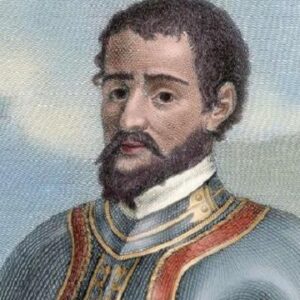Hernando de Soto was a conquistador and Spanish explorer who took part in the conquests of Central America and Peru. He is credited with leading the first European journey into modern-day American territory and discovering the Mississippi River. He grew up in an impoverished family and had an early interest in exploring. De Soto’s parents wanted him to become a lawyer, but he had already decided to travel the world. He was a competent horseman who, despite his youth, was chosen to accompany Pedro Arias Dávila on his trip to the West Indies. He soon became involved in the slave trade, which he found to be extremely profitable. His reputation as a brilliant explorer and astute merchant grew, and he was quickly promoted to second in command on Pizarro’s mission to Peru to explore and conquer the country. He was a key figure in the conquest of Peru and became a wealthy man as a result. His achievements fueled his desire to explore, and he embarked on a journey to North America. His North American mission was a massive operation that included everything from prospecting for valuable metals in the Southeast to securing a passage to China. Despite the fact that the expedition failed to achieve its primary goal, it had a number of significant effects.
Childhood and Adolescence
Hernando de Soto was born in Jerez de los Caballeros, Badajoz, Extremadura, Spain, in the year 1500. Despite their nobility, his parents were impoverished.
De Soto’s study at the University of Salamanca was financed by a noble benefactor named Pedro Arias Davila. His parents wanted him to study law, but Hernando was more interested in traveling across the world.
Later Years of Hernando de Soto
While still a youth, Hernando de Soto honed his horsemanship. De Soto was asked to join Davila, the governor of Darién, on his 1514 expedition to the West Indies as the captain of a cavalry exploration troop.
He proved to be an excellent explorer and dealer. While in Panama, he became involved in the slave trade and amassed a little fortune. He forged profitable relationships with Hernán Ponce de León and Francisco Campaón over the years, and by 1520, he had established himself as a prosperous merchant.
Gold was discovered south of Darién on the Pacific coast in the late 1520s, according to sources. Francisco Pizarro, an explorer, was given two ships by him to investigate the reports. De Soto was selected as Pizarro’s chief lieutenant during the mission.
In 1532, Pizarro and de Soto began their conquest of Peru. With his horsemanship, Hernando de Soto was instrumental in the Spanish triumph over the Incas at Cajamarca. They kidnapped the Inca king Atahualpa, who was ultimately slain, and looted the Inca’s wealth.
In 1536, Hernando de Soto returned to Spain with a sizable piece of the Inca’s wealth loot. For his accomplishments, he was lauded and respected at home. He could have settled into a comfortable life by now, having amassed considerable fortune, but he was restless for more experience.
During this period, he learned of Cabeza de Vaca’s expedition of Florida and the other Gulf Coast states, and he became inspired to do the same. His main motivation was to find the wealth he felt were lying in those uncharted territories.
He began preparing for his journey to North America by assembling a fleet of 100 ships and enlisting the help of 700 capable men. In April of 1538, he set sail. The expedition halted in Cuba en route to North America, where they assisted in the rebuilding of Havana after the French looted it.
In May 1539, they departed Cuba and made sail for Florida. De Soto and his soldiers spent the next three years exploring the area, and they were attacked by Indians throughout that time. The crew also traveled to Georgia and Alabama before heading west, where they discovered the Mississippi River’s mouth.
The expedition turned out to be dangerous. Even after three years, the men had not found the treasures they were looking for. Furthermore, about half of the soldiers and several horses had died from sickness or in combat with the indigenous people. Hernando de Soto did not live to see the mission to its conclusion.
Expeditions of Significant Size
Hernando de Soto is well known for leading the first European voyage deep into what is now the United States of America. During his journey, he traveled across the Mississippi River and became the first European to cross it. Despite the fact that he was unable to realize his dream of obtaining gold and silver on this journey, the expedition had countless far-reaching implications.
Personal History and Legacy
In 1537, he married Isabel de Bobadilla, his instructor Pedro Arias Davila’s daughter.
In 1538, he set out on an expedition to North America. During his excursions, he became unwell and died on May 21, 1542, while living in the town of Guachoya.
His remains is thought to have been buried in the Mississippi River.
DeSoto County (Florida), DeSoto State Park (Alabama), DeSoto Caverns (Alabama), and DeSoto Falls (Alabama) are only a few of the parks, towns, counties, and institutions named after Hernando de Soto (Lumpkin County, Georgia).
Estimated Net Worth
estimated net worth of Hernando de Soto is unknown.


